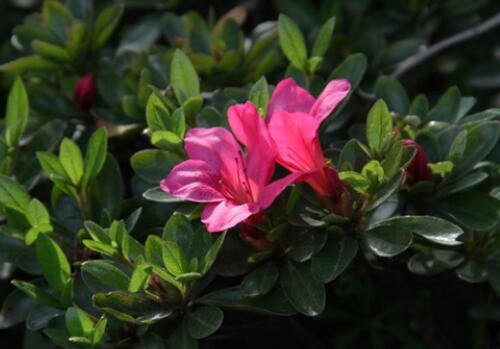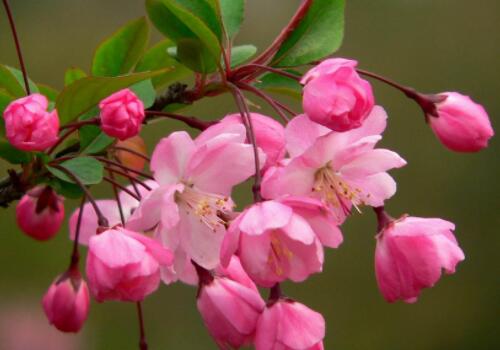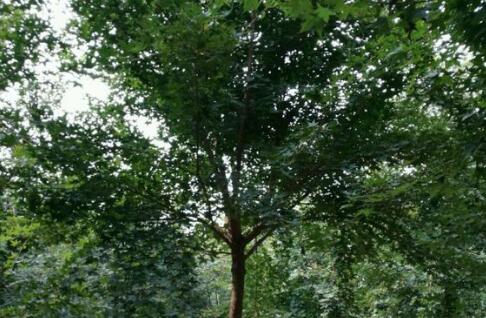When do summer cuckoos usually blossom? How many times a year can I drive? How much is the seedling price? What's the difference between spring cuckoo and spring cuckoo?
Summer cuckoo, also known as purple cuckoo, western cuckoo, Gaoyue rhododendron, is a kind of rhododendron. Traditional varieties are Changhua, Dahongpao, Wubao Green Pearl, Zichen Hall and so on. When does the summer cuckoo usually blossom? How many times a year can I drive? How much is the seedling price? What's the difference between spring cuckoo and spring cuckoo? What are the breeding methods? According to the data of Azaleaceae, the summer cuckoo branches first and blossoms the latest, usually from late May to June.

How many times a year can summer cuckoos open?
The average cuckoo blossoms once a year. If it is a cuckoo in four seasons, it blossoms in all seasons.
Four seasons green, four seasons flowering, there are yellow, red, white, purple four-color spectacle, four seasons cultivation, beautify the environment. It can be planted in pots or in shade. The summer cuckoo trees cultivated on the balcony should be pruned and arranged into spheres. Its shape is beautiful and beautiful. The summer cuckoo tree cultivated in the courtyard should be trimmed into an umbrella shape to add fun and beauty. It is suitable to be planted in groups under moist and shaded forests and rocks, and in gardens, it should be planted in trees, under forests, by streams, by pools and on the edge of lawns; it can be used as flower hedges and flowers on the back side of buildings. Some kinds can make bonsai.
How much is the price of summer cuckoo seedlings?
The price of seedlings will vary from place to place, the following is the collation of information, for reference only.
Seedling name height (cm) unit price (yuan) summer cuckoo 251.2-1.6 summer cuckoo 351.4-1.8 summer cuckoo 452.1-2.6
What is the difference between summer cuckoo and spring cuckoo?
1, shape: rhododendron tall, robust growth, young branches densely covered with brown bristles; summer cuckoo small, branches and leaves slender, branches dense, crown plump, neat.
2. Leaf shape: the leaves of rhododendron are large, long and rough and hairy; the leaves of summer cuckoo are narrow and closely arranged.
3. Flowers: the rhododendron is large and single, wide funnel-shaped, less double, the flower color is generally red, purple, pink and white and complex color; the summer cuckoo branches first and then flowers, flowering from mid-late May to mid-June.
4. Chunjuan is divided into two types: big leaves and small flowers; those that bloom in June are called summer cuckoos; those between spring and summer cuckoos are called spring and summer cuckoos; and those introduced from the west are separately classified as western rhododendrons, referred to as western rhododendrons.
Attached: culture method of summer cuckoo
1. Place of placement: summer cuckoos like to have semi-shady, warm and humid environment with scattered light. Due to the limited potted soil after potted plants, it is appropriate to keep them under the shade during the Dragon Boat Festival to the Mid-Autumn Festival. It is most ideal to face southeast and have buildings or trees in the northwest. You can also add hanging curtains to block the sunset during the summer. Put it daily on a 80cm high stone shelf, or set up wooden and cement slats, arranged in turn, so as to not only tidy and beautiful, but also reduce the damage of earthworms, insects and ants, and avoid the burning of damp and heat on the surface caused by the hot sun in the rainy season and summer thunderstorms.
2. Potted soil: the soil for the cultivation of summer cuckoo bonsai is required to deal with the contradiction between water, air and nutrients, so as to provide good growth conditions for the growth and development of summer cuckoo, so that its root system is well developed, the leaf color is dark green and the flower color is bright, so as to improve the ornamental effect of summer cuckoo bonsai. The ideal bonsai cultivation soil of summer cuckoo should have good aggregate structure, loose, good drainage and water retention performance, rich nutrition and slightly acidic material with PH value of 4 Murray 6. In Japan, deer marsh soil is widely used in Taiwan to cultivate summer cuckoos. Perlite matrix (A) can be used in China, followed by cinder, vermiculite and perlite plus vermiculite mixed matrix. The available sand and humus for which the above substrates could not be found were mixed at 3:7 or 1:1.
3. Planting: summer cuckoo bonsai materials are transplanted in spring, and healthy plants are selected, root washing is carried out first, and cultivated soil is replaced as soon as possible. Root washing is helpful to restore plant health, maintain plant vitality, clean roots, as well as the prevention of diseases and insect pests, and can trim the roots and get better root plates. In particular, the original general medium is field soil, and the root permeability is poor, which will affect the root extension and proliferation, so the root should be washed and replaced with better breathable cultivated soil as soon as possible. The plant that washes the root had better abandon the flower appreciation of that year. If the growth is not very healthy, or if the transplanting season misses spring, you should bring some mud balls as far as possible to keep the root system intact and facilitate the plant to resume growth as soon as possible. It is best to remove the mud pile around the root system, and then add a piece of cultivated soil to cultivate and plant, which is conducive to the expansion of the root system.
4. Diseases and insect pests: summer cuckoos are easy to suffer from all kinds of diseases and insect pests from the time of budding. after suffering from diseases and insect pests, the tree weakens, affecting the development of flower buds, and after many years of damage, it seriously weakens the growth, causing the branches and shoots to wither gradually until death. Therefore, from the beginning, it is necessary to carry out sterilization, disinfection and insecticidal work four times a month according to the actual situation. Common diseases and insect pests are: red spiders, military insects, longicorn beetles, coir moths, leaf roll moths, ants, brown spot, black spot, gall disease, chlorosis and so on. General pesticides, fungicides can be controlled, but yellow flower disease is mainly caused by the lack of trace elements such as iron and manganese in the soil. The cultivated soil should be changed in time, and 0.1% ferrous sulfate solution can also be sprayed on the leaf surface and basin soil.
5. Watering: the summer cuckoo has a habit of growing in a semi-shady environment, and is not resistant to drought. The requirement for dry and wet soil is moist but not wet (that is, the soil moisture is about 30%), so watering has become the most important lesson. If you use tap water to irrigate, you must first store it for one or two days and then use it after exposure to sunlight. High temperature in midsummer, avoid watering at noon, it is better to early morning or dusk, so as to avoid large temperature difference, affect root water absorption and interfere with plant physiological balance. There is no certain standard for the number of times, but it can be determined according to the environment of the site and the use of soil.
6. Flowering management: during the flowering period of summer cuckoo, the temperature rises gradually in early summer. In order to keep the color bright and the flowering period long, we should pay attention to proper shading and do not apply fertilizer. Avoid getting caught in the flowers when watering, and keep out the rain at the same time. Remove withered flowers in time to avoid falling on the potted soil to breed germs. When flowers bloom to 70% or 80%, they should be picked and pruned as soon as possible. According to the physiological habits of the summer cuckoo, its flower buds differentiate at the top of the new branches, and the flower buds can only be formed when the temperature is above 27 °C in the daytime and above 18 °C at night, and the flower buds can only be nurtured under the long sunshine of 16 hours per day. Therefore, July and August coincide with the period of flower bud differentiation and gestation of summer cuckoos, so pruning must be completed before late June, too late to affect next year's flowering.
7. Fertilization: in the growing period of spring and autumn, the principle of fertilization is to apply thin fertilizer diligently. Liquid fertilizer must be fully fermented for about half a year. Fertilization must be timely and appropriate, otherwise it will cause fertilizer damage, resulting in the gradual death of the root system until the whole plant dies. Fertilization had better be carried out before the evening, and fresh water should be irrigated again the next morning. Summer cuckoo topdressing is mainly after anthesis, because the plant consumes a lot of nutrients during flowering. With the sprouting of leaf buds and the elongation of new shoots, a large amount of nutrients are needed, but the nutrients in the basin soil are limited, so topdressing every ten days or so promotes the luxuriant and sturdy branches and leaves of new shoots, which is beneficial to flower bud differentiation. After October, the physiological activity of summer cuckoo gradually weakens, it is not suitable to apply fertilizer before the leaves are warm in spring, and fertilization should be stopped during flowering.
8, shading: the summer cuckoo most avoid direct sunlight and sunset during the hot summer, entering the hot summer temperature above 30 °C, continuous high temperature, dry air, it is best to shade during this period of time to prevent high temperature from burning leaves. In autumn, when the temperature is below 25 °C, there is no need for shade.
9. Pruning and hanging: pruning and pruning of summer cuckoo bonsai is an important measure in daily maintenance and management, which can regulate growth and development, thus promoting exuberant growth and luxuriant flowers. And make the tree neat and graceful. Pruning can be divided into strong pruning, pre-flowering pruning, post-flowering pruning and daily pruning.
Time: 2019-03-19 Click:
- Prev

How much is the price of deciduous small trees and Begonia seedlings? When will it blossom? How long is the florescence? The fruit is edible.
Tripterygium is a small deciduous tree, up to 5 meters high, with a crown spread in Jiangsu, Zhejiang, Anhui, Shaanxi, Sichuan and Yunnan. So how much is the price of Begonia seedlings? When will it blossom? How long is the florescence? Can the fruit be eaten? What are the breeding methods? I know from the Rosaceae data
- Next

What are the planting prospects of Yuanbao maple, "gold ingot and Yuanbao"? What are the cultivation techniques? What is the difference between Wujiaofeng and Wujiao maple?
Acer truncatum belongs to Aceraceae and Acer genus. It is a deciduous tree with a height of 8m and 10m, and its bark is split longitudinally. Yuanbao Maple is a treasure all over its body. It gets its name because the Samara is shaped like a gold ingot in ancient China. It is a unique tree species in China. What are the planting prospects of Yuanbao maple? What are the cultivation techniques? Acer truncatum is a deep-rooted tree species with strong sprouting power.
Related
- Fuxing push coffee new agricultural production and marketing class: lack of small-scale processing plants
- Jujube rice field leisure farm deep ploughing Yilan for five years to create a space for organic food and play
- Nongyu Farm-A trial of organic papaya for brave women with advanced technology
- Four points for attention in the prevention and control of diseases and insect pests of edible fungi
- How to add nutrient solution to Edible Fungi
- Is there any good way to control edible fungus mites?
- Open Inoculation Technology of Edible Fungi
- Is there any clever way to use fertilizer for edible fungus in winter?
- What agents are used to kill the pathogens of edible fungi in the mushroom shed?
- Rapid drying of Edible Fungi

